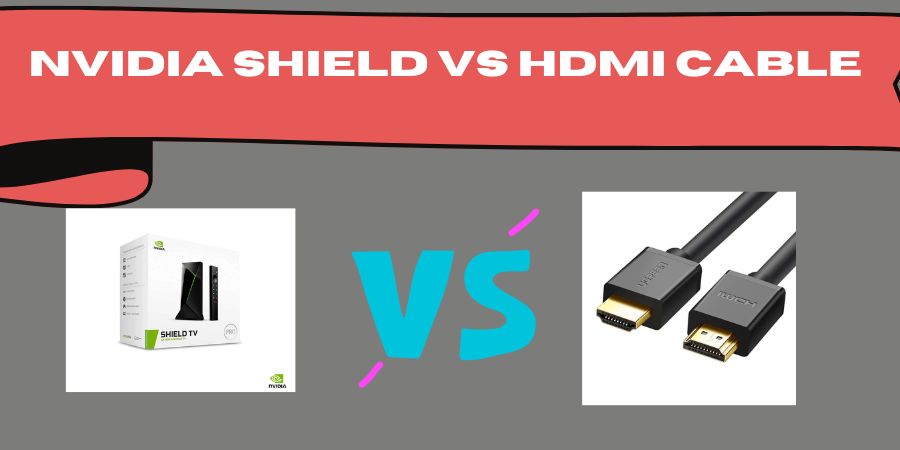Today, we’re diving into a comparison that’s bound to spark some interest.
In one corner, we have the mighty NVIDIA Shield, a powerful streaming device that promises an exceptional entertainment experience.
And in the other corner, we have the humble HDMI cable, a trusty companion for connecting your devices. Let’s explore the five key differences between these two contenders and see which one comes out on top!
The Ultimate Streaming Power: NVIDIA Shield Reigns Supreme
When it comes to streaming, the NVIDIA Shield takes the crown. With its cutting-edge technology, the Shield offers a seamless and immersive streaming experience like no other.
It supports 4K HDR content, Dolby Vision, and Dolby Atmos, ensuring that you enjoy your favorite movies and shows in stunning detail and breathtaking audio.
On the other hand, HDMI cables are limited to transmitting video and audio signals and don’t offer any additional streaming capabilities.
Versatility at Its Best: NVIDIA Shield Takes the Lead
While HDMI cables serve a specific purpose, the NVIDIA Shield goes above and beyond. It not only connects your TV or monitor to other devices but also acts as a versatile media hub.
The Shield allows you to access popular streaming platforms, play games, and even stream your PC games to your TV.
With its vast app ecosystem and powerful processing capabilities, the NVIDIA Shield brings versatility to a whole new level.
Cutting the Cord: NVIDIA Shield Brings Wireless Freedom
One significant advantage of the NVIDIA Shield is its wireless connectivity options. It supports both Wi-Fi and Bluetooth, eliminating the need for physical connections.
This means you can say goodbye to messy cable setups and enjoy a clutter-free entertainment system.
In contrast, HDMI cables require a physical connection between devices, which can limit flexibility and create cable tangles.
Gaming Galore: NVIDIA Shield Delivers the Thrills
If you’re a gaming enthusiast, the NVIDIA Shield is your ultimate sidekick. With its powerful NVIDIA Tegra X1+ processor, the Shield can handle demanding games with ease. It supports popular game streaming services like NVIDIA GeForce NOW and even has its own game library. You can also connect a game controller to the Shield for an immersive gaming experience.
On the other hand, HDMI cables solely transmit audio and video signals, without offering any gaming-specific features.
Future-Proof Technology: NVIDIA Shield Stands Tall
In the world of technology, staying up-to-date is crucial. The NVIDIA Shield embraces this philosophy by regularly receiving firmware updates and feature enhancements. This ensures that you’re always equipped with the latest advancements in streaming and gaming technology.
HDMI cables, on the other hand, remain static and do not receive updates to enhance their capabilities.
Smart Assistant Integration: NVIDIA Shield Offers Voice Control
One standout feature of the NVIDIA Shield is its integration with smart assistants like Google Assistant. With a simple voice command, you can control your streaming experience, search for content, adjust volume, and even control other smart devices in your home.
HDMI cables, on the other hand, do not offer built-in smart assistant integration, limiting your control options to manual adjustments.
App Ecosystem and Customization: NVIDIA Shield Takes the Lead
The NVIDIA Shield boasts a robust app ecosystem, allowing you to access a wide range of streaming platforms, games, and productivity tools. Moreover, it offers customization options to tailor your home screen, app layout, and recommendations according to your preferences.
HDMI cables, being a physical connection medium, do not provide any app ecosystem or customization capabilities.
Local Media Playback: NVIDIA Shield Excels
If you have a collection of locally stored media, the NVIDIA Shield is the clear winner. It supports various media formats and has built-in media player apps that can handle your movies, TV shows, music, and photos with ease. Additionally, you can connect external storage devices to expand your media library.
HDMI cables, on the other hand, solely transmit media from one device to another and do not offer any local media playback features.
Content Upscaling and Enhancement: NVIDIA Shield Elevates Visuals
With the NVIDIA Shield, you can enhance your viewing experience even further. It features advanced upscaling technology, such as AI-enhanced upscaling, that can upscale lower-resolution content to near 4K quality, resulting in sharper and more detailed visuals.
HDMI cables, however, do not have any built-in upscaling capabilities and transmit the content as it is without any enhancements.
Portability and Travel-Friendliness: HDMI Cable Takes the Lead
While the NVIDIA Shield offers a multitude of features, it may not be the most travel-friendly option due to its size and complexity. On the other hand, HDMI cables are incredibly portable and easy to carry around, making them a convenient choice for connecting devices on the go.
So, if you frequently travel and need a quick and simple connectivity solution, HDMI cables have the upper hand.

